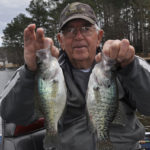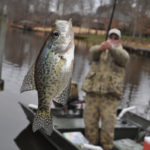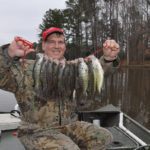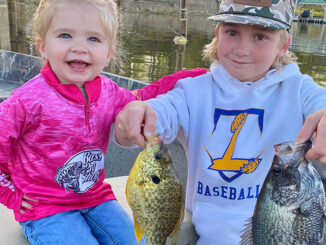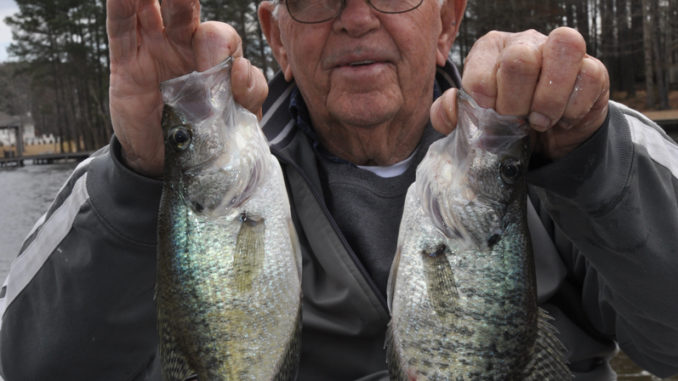
Tiny Nash County lake is loaded with outstanding population of white crappie.
Just as anglers do in early spring, Tar River Reservoir suffers mood swings. One day, the water is clear. The next day, it rains, bringing muddy runoff surging down its feeder creeks. The brick-colored water can cause crappie fishing to crash. Then, the water clears again and the rising water temperature from those spring rains heats up the crappie bite.
Just three vehicles with boat trailers were in the parking lot of Saponi Creek ramp. Obviously, muddy water and a chilly day kept half-hearted anglers away. One vehicle’s license plate read “2 POUND”, giving a clue as to the angler’s peculiarity of purpose.
The angler was Tommy Short, a 79-year-old retired farmer from nearby Rocky Mount. Despite the conditions, he launched his Bass Tracker aluminum boat, slowly circling a cove in the 1,860-acre lake, impounded in 1971 southwest of Rocky Mount in Nash County, studying his depth finder screen, trying to locate a school of crappie, the species that has brought the lake the most recognition.
“I have only caught 28 crappie big enough to keep, so far,” said Short, who won’t keep a crappie less than 9 or 10 inches long. “I let a lot of little fish go.”
Shortly thereafter, he found a school and picked up one of his rods, which held line as thin as a spider’s web. Questioning his line selection proved a testy subject.
“I only fish with 2-pound test,” he said. “I see some crappie on the edge of this channel. I don’t fish for them until I see them with my depth finder.”
Short had tied on a tiny hair jig. He pinched the bend of the hook, drawing the line tight and putting a deep bow in his ultra-light spinning rod. When he let it go, the jig flew 30 feet.
“I call that shooting a jig,” he said. “I can shoot a jig with enough accuracy to land it way back under a low dock, which is where the big ones usually are. Even with 2-pound test and an ultralight rod, you can’t cast a jig that weighs 1/100 of an ounce very far the conventional way.”
Short said the fish he was catching were smaller than usual, but the year was young. He catches crappie every month.
“I even catch them during hot weather because I’m a crappie expert,” he said. “It’s the only fish I fish for now. Years ago, I formed a bass club and fished tournaments under the schedule that everyone else wanted for 25 years. Now, I fish on my schedule.”
After Short finds fish with his depth finder, he uses fluorescent floats to mark the area before he begins fishing. He makes his own jigs, casting the heads in molds, applying epoxy paint and baking it on, applying clear coat, and tying a Craft Fur dressing with 140-denier waxed string. His heaviest jig is ¼-ounce and the lightest, 1/100-ounce.
“I find the fish by running the channel edge at different depths, following contours,” he said. “If the fish are scattered, sometimes I troll, but most of the time I find a tight school and cast a jig. You don’t have to move the jig up and down because the fur makes it look like it is breathing. You can’t hold it still even if you try. I hold the rod and fish out one side. If a partner is in the back of the boat, he is fishing on the other side. If you are holding the rod and the fish flares his gills to suck the jig in, you feel it and set the hook. You can’t do that if it is a light bite and the rod is in a holder.”
Often, Short locates fish schooling around structure such as a downed tree or brush pile. If the structure is shallow, the fish may not bite.
“Once I find some structure and drop a marker on it, I move out so I can fish away from it,” he said. “The chance of catching crappie is greater if you cast to the structure than if you are running all over top of them. It takes a lot to spook them, but if you know they are there and they stop biting, you did. That is a good time to go fishing somewhere else for a while. When you come back, they will be biting again.”
Butch Foster of Southport runs Yeah Right Charters for saltwater fishermen, but he’s a crappie-fishing veteran
“Tar River Reservoir is only a couple hours’ drive from Southport,” Foster said. “It is also smaller than the better-known lakes, which makes it ideal for fishing on windy days. It has narrow coves and high banks with trees to block the wind. It also has lots of docks.”
Foster likes fishing visible structure. While he uses many tactics to catch crappie, at Tar River Reservoir, he reverts to old-school methods.
“The boat docks are the best places,” he said. “Even if you don’t know much about fishing, you can always find a boat dock that has crappie.”
Foster uses two methods to fish docks. Like Short, he “shoots” docks, but uses a slip-float rig baited with a minnow rather than a jig.
“You don’t want to put so much bend in the rod that the minnow rips off when you let go,” he said. “The weight of a float, sinker and minnow gives it plenty of momentum. If you can’t swing or cast the float under a dock far enough, you can usually shoot it to the sweet spot.”
Foster’s other method is using a telescoping fiberglass pole. He pokes the tip under the dock, dangling hook, line, sinker and minnow.
“Sometimes, the biggest fish are way back where the cross braces meet,” he said. “If there are boats tied up with ropes going everywhere, shooting a jig or minnow under a dock is only inviting a snag or tangle. With a long pole, I can reach all the way back under any dock — between a boat and a finger pier or under a boat’s mooring lines — and still haul out a crappie you would never have gotten to with any type of cast. I use the tip of the pole to maneuver the float exactly where I want it. I also use it to jiggle the hook free if it gets snagged.”
Tar River Reservoir has so many docks it is difficult to know where to begin fishing. However, Foster said there is no real trick to finding them.
“In February and early March, the water is cold, so the fish aren’t back in the coves to spawn,” he said. “I start fishing main- channel docks, then docks around the mouths of coves and creeks, trying to find the ones that are most accessible. If there are boats in the way, I either skip that dock or fish the outside edges before moving to the next one. Eventually, I find one stacked up with slabs.”
Foster and Short agree the reservoir has some of the best crappie fishing in North Carolina, having produced two state records for white crappie in the past. However, what makes it special is its location in the middle of the state’s coastal plain.
“I fish Lake Gaston and Roanoke Rapids Lake in North Carolina, Santee-Cooper in South Carolina and the Potomac River in Virginia,” Short said. “I can say that Tar River Reservoir is the best lake for crappie fishing in this state, but what I like most about it is that it is so close to my home.”
Kirk Rundle, a fisheries biologist with the N.C. Wildlife Resources Commission, said the key to the lake’s fertility is the sediment-laden runoff. By having no daily creel limit or size minimum, the Commission encourages fishermen to remove plenty of fish.
“The fish are not overharvested, with relative weights average to good,” Rundle said. “Their condition is not phenomenal so it helps to thin them out.”
The cyclic nature of crappie populations in small lakes has a prime example in Tar River Reservoir. Rundle said two state-record crappie caught in 2010 were the result of a large class of fish in 2003-04. By 2008, the number of 10-inch in samples was amazing.
“A 10-incher is typically age 3,” he said. “At age 4, they can be 14 or 15 inches long and weigh 2 pounds, with a 4-pounder possible at age 6 or 7. But we had a drought in 2011, which hurt the population of large fish. By 2013, we were seeing plenty of cookie-cutter fish, 7 to 8 inches long. In 2015, our catch rates were the best I have ever seen, so 2016-17 should be very good years. I would not be surprised to see another state record within a couple of years. In fact, I am sure there is a state-record swimming in the reservoir right now.”
DESTINATION INFORMATION
HOW TO GET THERE — From Raleigh, take us 64 east and US 264 toward Rocky Mount, then take NC 97 east, crossing I-95, then turning left onto Old Carriage Road, two miles to the Saponi Creek access or 1 mile to Bend of the River Road to the main boating access.
WHEN TO GO — Peak months are February-May.
BEST TECHNIQUES — Drop jigs with white fur trailers vertically to schools of crappie suspended along channel edge, or fish live minnows on slip-float rigs on long poles around boat docks. A short, light spinning rod-and-reel combo spooled with 2-pound Sufix or Vicious mono helps with sensitivity when jig fishing. When fishing live bait, use a 10- to 12-foot fiberglass pole like South Bend’s Crappie Stalker.
FISHING INFO/GUIDES — Reservoir Country Store, 252-212-1733. See also Guides and Charters in Classifieds.
ACCOMMODATIONS — Hampton Inn Rocky Mount, 252-937-6333; Comfort Inn-Gateway, 800-228-5150.
MAPS — DeLorme’s North Carolina Atlas and Gazetteer, 800-452-5931, www.delorme.com. Lake maps are also available at local tackle shops and City of Rocky Mount website, www.rockymountnc.gov/police/adminservices.

